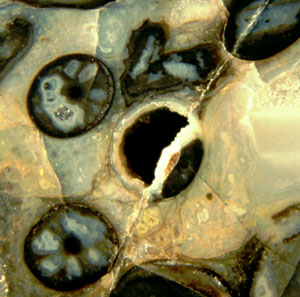Twin patterns - a clue to void formation in Rhynie chert plants
Large voids occasionally seen in the tissue of several
plant species in
the Rhynie chert (Lower Devonian), appearing as conspicuous patterns on
cross-sections, have been arguably explained as a result of drying or
decay of the dead plant [1]. Contrary evidence comes from the rare
phenomenon of pairs of patterned sections with similar aspect
(Figs.1,2). Incidental formation of such pairs would be quite
improbable. Drying or decay would not produce strikingly similar
patterns.

Fig.1: Aglaophyton
sections, two of them with voids arranged in similar
patterns:
one large void and four smaller ones.
The similarity rules out
incidental void formation by decay and shrinkage.
Note also the fungus hyphae seen as dark filaments beneath the hollow
straw (centre)
 Fig.2 (right):
Aglaophyton
sections, two of them with similar voids and with
odd shape, suggesting their relation as prongs of a forked shoot.
Fig.2 (right):
Aglaophyton
sections, two of them with similar voids and with
odd shape, suggesting their relation as prongs of a forked shoot.
The similarity of aspect hints at abnormal growth as a cause of void
formation in Rhynie chert plants.
The similar aspect of two neighbouring sections
strongly suggests that
they represent the prongs of a forked shoot, with each prong having
inherited the cause of void formation from their common base. Thus the
phenomenon of twin patterns leads to the conclusion that the voids were
formed in the living plant, very probably by abnormal growth due to
fungus
infection. This is supported by the observation that well preserved
samples show intact tissue around the voids.
(See
Rhynie
Chert News 4.)
H.-J. Weiss
2007
[1] www.abdn.ac.uk/rhynie
 |
 |
21 |



 Fig.2 (right):
Aglaophyton
sections, two of them with similar voids and with
odd shape, suggesting their relation as prongs of a forked shoot.
Fig.2 (right):
Aglaophyton
sections, two of them with similar voids and with
odd shape, suggesting their relation as prongs of a forked shoot. 
